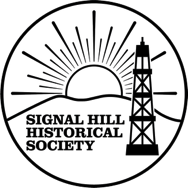View of the Gods – The Trackless Trolley
Written by Claudine Burnett
Learn more at: http://claudineburnettbooks.com
The Pacific Electric Company began the construction of a line up the Hill in 1906, but gave it up because the grade was too steep. In December 1910, our friend George Hughes, real estate promoter extraordinaire, convinced Signal Hill property owners that if the Pacific Electric couldn’t run trains up the Hill perhaps a trackless trolley system was needed.
The plan called for busses equipped with 20-horsepower motors, capable of carrying a load of 3600 pounds. The motors would be heavy enough to take such a load to the summit of the Hill. Electric lights were to be used throughout the 22-foot long, 6 foot wide cars, which would be able to hold 24 people. The roof was to extend from the rear door to the dash, with a ladder either at the side or rear for access to the roof. Another detail according to historian Walter Case was that “the driver’s seat would be in a position back of the steering wheel, which would accommodate one person and would be trimmed with split leather or cushion and back trimmed with hair.” (Sun 12/3/1937)
At this December 12, 1910, meeting George Hughes announced that a Los Angeles resident wanted to establish a telescope on the summit of the hill, also a lunch room, and, just possibly a dance floor. Hughes said he was willing to lease to the prospective developer a space of not more than 100x150 feet at any desirable point.
But neither the trackless trolley nor the telescope pavilion became a reality.
Aerial Tram
While the trackless trolley plan was being discussed another more spectacular idea was suggested to Hughes. Los Angeles resident Fletcher E. Felts decided it was time to construct an aerial tram from Long Beach to Los Angeles and also to Pasadena.
His proposal was for what he called a “Suspended Auto Motor Railway,” consisting of a rail track from which would be hung cars that would have a clearance of at least 14 feet from the ground. Towers which would provide supports for the track would be constructed “at intervals of whatever distance may be required.”
The cars would be propelled by either electricity or gasoline and hang from wheels clamped to the rail. It would be possible said Mr. Felts, for the cars to climb almost any grade, but he stated that if the grade became as steep as 60 percent the use of cogs to prevent slipping would be advisable.
On such a road, he maintained, a speed of two miles a minute could be obtained with no danger to the passengers. He estimated the trip from Long Beach to Los Angeles would be made in 15 minutes and that a ride from Long Beach to Pasadena would not take more than 25 minutes. Cars could be provided, he said, to carry from 20 to 100 passengers each, but he advised 50 passenger cars on the Long Beach-Los Angeles line.
He told interested parties he had contracts by which the delivery of such cars here for the line would be assured. Such cars, he added, were then being operated in Germany. His holdings, he said were covered by 152 patents.
The fact that the per-mile cost of the undertaking was estimated at from $20,000 to $50,000 depending on the character of the terrain on which the towers would have to be constructed contributed to the futility of Mr. Felts’ efforts to make Long Beach aerial-railway conscious.
All of Hughes’ dreams about Signal Hill would have come true if the Hill hadn’t been so steep. None other than Henry Huntington planned on building a large hotel costing no less than $100,000 on the summit, but he backed out when the Hill proved too steep for his electric railway. The Los Angeles Herald (10/30/1904) reported that 115 acres of the Signal Hill tract would be open for development, while five acres would be reserved for the hotel. In addition fine gardens and many attractions were planned. But as this blog has shown, Hughes was not one to give up easily. He lived to see the Hill transformed almost overnight when oil was discovered in 1921. What would have happened to the hotel, university, and trackless trolley system if they had been built? We will never know.
Claudine Burnett
Learn more at: http://claudineburnettbooks.com
Photo: This was the nation's first trackless trolley, built by Charles Spencer Mann in 1910 to promote vacation lots in Laurel Canyon.

